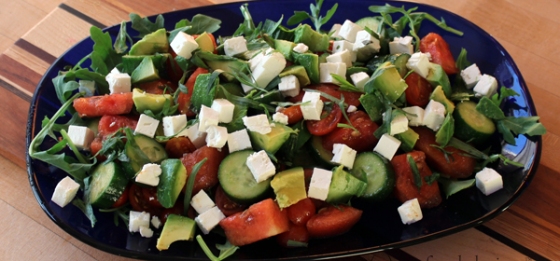Beets are a year-round veggie staple here in California. The varieties available to us vary throughout the year, but beets in some form are available at just about every farmers market around, not to mention the big grocery chains. And like potatoes, they’re crazy adaptable, perfect in spring salads, earthy breakfast hashes, and chocolate cake. They’re better roasted than boiled. We scrub them clean, trim their greens and wrap them in foil to roast in a hot oven. Roasted beets are easy to peel once they cool a bit. They’ll keep in the fridge for a week in a sealed container.
Garden variety red beets are sweet and delicious. But if you’re able to get your hands on some beautiful golden or variegated varieties like chioggia beets, buy them. Their colors are beautiful and less likely to “bleed” than dark red varieties like Bulls Blood. We’ve roasted beets that look like jewels after roasting, with beautiful golds and pinks swirling around in them. They’re a fun way to play with color and texture in all kinds of dishes.
When we’re on our game, we buy beets with greens, rather than trimmed bulk beets, because the greens are delicious and they’re nutritious, long stalks and all. They’re tender enough to eat raw, but their mild flavor makes them endlessly useful in any recipe that calls for fresh greens. We use them in soups and risottos for added color and bite. We really love these pickled beet greens. They’re crunchy, vinegary and a little spicy, the perfect partner to anything you’d embellish with hot sauce or salsa or pickles. Of course, you can pickle just about any green, but if you’re looking to put a bunch of beet greens to better use than building compost, pickle them.
Roasted Beet Roots
A bunch of beets (4-5 beet roots) with the greens intact
2 tablespoons olive oil
Salt
Preheat the oven to 425 degrees.
Cut the stems from roots, setting the stems and leaves aside in cold water to clean and hydrate. Scrub the beet roots with a bristly brush to remove all mud and dirt. Dry the beets with paper towels.
On a baking sheet or in a roasting pan, place a large piece of aluminum foil in the bottom, enough to fold over the beets. Place the beets in the center of the foil and drizzle about 1-2 tablespoons of olive oil over them. Sprinkle liberally with salt, 1-2 tablespoons. Seal the beets inside the foil. Put the tray in the oven and roast for 40-60 minutes or until a knife pierces a beet easily. Remove from the oven and let cool for about an hour. Once cool enough to handle, using paper towels, peel the skins off the beets. The skins should easily slip off. Sometimes a paring knife is useful for peeling the beets if you want to take a more fussy approach.
Once the skins are removed, the beets can be sliced, diced, or served quartered. Keep them refrigerated and use in a salad or add to potato hash.
Pickled Beet Greens
Stems and leaves from a bunch of beets, and/or other greens
1/2 cup distilled vinegar
1/2 cup apple cider vinegar
2 tablespoons sugar
a good pinch of chili flakes
a good pinch of salt
pepper
In a medium pan, fill halfway with water. Bring to a boil and reduce to a simmer. Meanwhile, clean and hydrate the beet stems and leaves in a bowl of ice water. Spin dry and separate the stems and leaves. Chop the stems into 1/8” pieces. Set aside. Combine all the leaves as tightly as possible, layering leaves on top of one another. Roll tightly, chop into 1/8”-1/4” strips. Chop the strips a few times to get smaller pieces. Set aside.
Add a pinch of salt to the boiling water then add the beet stems. Simmer for 3 minutes, then add the beet leaves. Simmer for 3 more minutes. Drain the stems and leaves (the water can be saved and used to flavor soups). Move the hot greens to a mason jar.
Over medium heat in a small pan, heat the vinegar, sugar, chili flakes, and salt. Heat until it almost comes to a boil. Pour the hot vinegar over the stems and leaves. Cover and allow to sit at room temperature until the stems cool completely. Once cooled, refrigerate for at least three days before using.
Add pickled beet greens to salads, soups, toasted bread, pizza, rice bowls.



